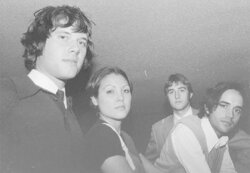Surfacing ghosts
Faster Than Walking at Miller’s
Tuesday, February 12
As we approached the door and noted only a lonely table perched on the raised, coop-like stage in the fishbowl of Miller’s front Window, my cover-allergic companion sighed, “Yay, no music.” But a night at Miller’s without music— be it good or bad, jazz, rock, folk, or bluegrass— is no night at all. After sitting down and listening to several bars of Faster Than Walking’s old-timey jams, I thought, “Yay, music.”
On this night I’d truly caught the six-piece combo in medias res— in the middle of their first set and smack in the middle of the sclerotic stream of tables and chairs. The band/audience proximity helped lead to this exchange:
Guy at Bar: “You guys sound like those Hackensaw Boys.”
Band Member #1: “Aw, those guys stole all our stuff!”
Band Member #2: “And made it better!”
Though their lawn might have a turquoise tint to it, Faster Than Walking, whose members range from 20something to 50ish, mustachioed to dreadlocked, aren’t necessarily a bluegrass band. Strings, disturbed at a similarly furious pace, are strummed more often than picked, and the music sounds and feels older than Bill Monroe’s 20th century concoction.
Sometimes way older. “This is the best Irish music I’ve heard in a while,” remarked one listener. There’s something besides a few Guinesses to his point: the same Scotch-Irish ghosts that surface in the dialect of some Southerners wail on in the band’s twin fiddle attack. Coasting above the hitch-stepped rhythm of acoustic guitar, banjo, and upright bass, the fiddles’ high lonesome sounds signified highlands as much as the peaks and foothills of Appalachia.
Savoir Faire, with Bottom of the Hudson, at the Outback Lodge Thursday, February 14
“He needs to sing from his diaphragm. He’s not singing from his diaphragm.”
Such was the constructive criticism offered by my listening companion after we witnessed the thoroughly vital set of local indie rock power trio Bottom of the Hudson. And perhaps the group’s lead singer could afford to ease off the vocal chord constriction, which squeezes out an accent somewhere between American and British (not unlike, at times, Guided by Voices’ Robert Pollard).
But any criticism of the band’s smart and beefy guitar-driven bombast has to be informed by the sensation that the group’s songcraft— the evolution of which has been astounding since I last caught them, as a four-piece, late last summer— is on the verge of reaching a wholly unique and special place.
On this night, with the lead vocals slightly submerged below the waterline of the instrumental mix, attention was commanded by the frontman’s guitar heroics. Treating his tone to generous helpings of distortion, he grifted watery, domestic Pavement-style leads, the syrupy almost-dissonance of Daydream Nation-era Sonic Youth, and the thick basement anthem chords of latter day Guided by Voices with smiles and smirks.
Though they don’t cultivate the same pop sensibility that GBV has of late (itself an update of the sepia tones of Big Star and Cheap Trick), Bottom of the Hudson do aim for a similar crossroads of nostalgia and the here-and-now, an x that marks the spot where memory catalyzes present circumstances, and vice versa. They’re also unafraid to be blunt, like when they stretch their legs across a groove-based mediator that could be the missing link between Aerosmith’s “Sweet Emotion” and the Smashing Pumpkins’ “Cherub Rock”
Don’t mistake the name-dropping for strict re-creationism. Though their sound undeniably sets one to browsing the record collection of the mind (and theirs is obviously a good one), every song sounds first and foremost like a Bottom of the Hudson song. You can hope for stronger vocals, and more assertive drumming, and a more consistent sense of tightness. Many songs don’t quite put out, and you’re left wondering what would get you past second base.
Try not to get frustrated. If Bottom of the Hudson’s a bit of a tease, stick around for the show. They’re giving and we’re getting some now. Their sound’s a promise that soon enough we’ll all be rounding third and chugging for home.
Savoir Faire, on the other hand, are a bit more chaste. Though the quartet had the home-field advantage— Bottom of the Hudson, though they handled it with goofy aplomb, criminally lacked the present support of a crowd that came unglued from the bar only after the headliners took the stage— you’d need some funny math to hear a sum that was equal or greater than the competent parts.
Advertised as mods, the band did look the part: collared shirts, slim slacks, boots. High and dexterous leads over jazz-pop chords, monosyllabic (i.e., la’s, bop’s, and ba’s) female backing vocals, a conspicuous affinity for the Beatles, and fleeting similarities to U.K. pop gem sculptors Teenage Fanclub were also called upon, albeit unpredictably, and without the consistency to satisfy the mod appellation. Or, more simply, to satisfy.
Most prominent was the country tinge to the lead singer/rhythm guitarist‚s vocals, though the drummer and lead guitarist quietly came across as the most accomplished of the group. Perhaps a little too quietly, the latter dourly layered constant, workman-like solo work under the second guitar.
His detachment, and his work’s technically solid but emotionally flat quality, summed up Savoir Faire’s conundrum: neither for better nor worse, no component stood up to be counted. With unremarkable stats, adding up this equation required some sort of spark or chemistry that was conspicuous in its absence.
